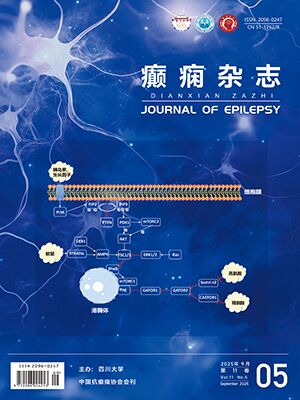| 1. |
Potschka H, Trinka E. Perampanel: Does it have broad-spectrum potential? Epilepsia, 2019, 60: 22-36.
|
| 2. |
卫材(中国)药业有限公司. 吡仑帕奈药品说明书. 2021.
|
| 3. |
Eisai Co. , Ltd (per FDA). Perampanel label. 2019.
|
| 4. |
Eisai Co. , Ltd (per EMA). Perampanel label. 2021.
|
| 5. |
Eisai Co. , Ltd (per PMDA). Perampanel label. 2020.
|
| 6. |
Schulze-Bonhage A. Perampanel for epilepsy with partial-onset seizures: a pharmacokinetic and pharmacodynamic evaluation. Expert Opinion on Drug Metabolism & Toxicology, 2015, 11(8): 1329-1337.
|
| 7. |
Italiano D, Perucca E. Clinical pharmacokinetics of new-generation antiepileptic drugs at the extremes of age: an update. Clinical Pharmacokinetics, 2013, 52(8): 627-645.
|
| 8. |
May TW, Boor R, Rambeck B, et al. Serum concentrations of rufinamide in children and adults with epilepsy: the influence of dose, age, and comedication. Therapeutic Drug Monitoring, 2011, 33(2): 214-221.
|
| 9. |
May TW, Boor R, Mayer T, et al. Concentrations of stiripentol in children and adults with epilepsy: the influence of dose, age, and comedication. Ther Drug Monit, 2012, 34(4): 8.
|
| 10. |
Wallander K, Ohman I, Dahlin M. Zonisamide: pharmacokinetics, efficacy, and adverse events in children with epilepsy. Neuropediatrics, 2014, 45(6): 362-369.
|
| 11. |
Majid O, Reyderman L, Ferry J, et al. Population pharmacokinetics and exposure-response analyses of adjunctive perampanel in pediatric patients with epilepsy. the 72nd Annual Meeting of the American Epilepsy Society, 2018.
|
| 12. |
Renfroe JB, Mintz M, Davis R, et al. Adjunctive perampanel oral suspension in pediatric patients from ≥2 to <12 years of age with epilepsy: pharmacokinetics, safety, tolerability, and efficacy. Journal of Child Neurology, 2019, 34(5): 284-294.
|
| 13. |
Ikemoto S, Hamano S, Hirata Y, et al. Efficacy and serum concentrations of perampanel for treatment of drug-resistant epilepsy in children, adolescents, and young adults: comparison of patients younger and older than 12 years. Seizure, 2019, 73: 75-78.
|
| 14. |
Ishikawa N, Tateishi Y, Tani H, et al. Clinical profiles associated with serum perampanel concentrations in children with refractory epilepsy. Epilepsy & Behavior, 2019, 94: 82-86.
|
| 15. |
Gaudio E, Gienapp AJ, Wheless J. Perampanel pharmacokinetics in children: correlation of dose with serum concentrations. Journal of Child Neurology, 2019, 34(8): 427-431.
|
| 16. |
Yamamoto Y, Shiratani Y, Asai S, et al. Pharmacokinetics, tolerability, and clinical effectiveness of perampanel in Japanese patients with epilepsy. Seizure, 2020, 83: 181-186.
|
| 17. |
Takenaka O, Ferry J, Saeki K, et al. Pharmacokinetic/pharmacodynamic analysis of adjunctive perampanel in subjects with partial-onset seizures. Acta Neurologica Scandinavica, 2018, 137(4): 400-408.
|
| 18. |
Yamamoto Y, Usui N, Nishida T, et al. Therapeutic drug monitoring for perampanel in Japanese epilepsy patients: influence of concomitant antiepileptic drugs. Therapeutic Drug Monitoring, 2017, 39(4): 446-449.
|
| 19. |
Gidal BE, Ferry J, Majid O, et al. Concentration-effect relationships with perampanel in patients with pharmacoresistant partial-onset seizures. Epilepsia, 2013, 54(8): 1490-1497.
|
| 20. |
Patsalos PN. The clinical pharmacology profile of the new antiepileptic drug perampanel: a novel noncompetitive AMPA receptor antagonist. Epilepsia, 2015, 56(1): 12-27.
|
| 21. |
Rohracher A, Kalss G, Leitinger M, et al. Two-year real-world experience with perampanel in patients with refractory focal epilepsy: Austrian data. Therapeutic Advances in Neurological Disorders, 2016, 9(6): 445-453.
|
| 22. |
Yamamoto T, Lim SC, Ninomiya H, et al. Efficacy and safety of perampanel monotherapy in patients with focal‐onset seizures with newly diagnosed epilepsy or recurrence of epilepsy after a period of remission: The open‐label Study 342 (FREEDOM Study). Epilepsia Open, 2020, 5(2): 274-284.
|
| 23. |
Fogarasi A, Flamini R, Milh M, et al. Open‐label study to investigate the safety and efficacy of adjunctive perampanel in pediatric patients (4 to <12 years) with inadequately controlled focal seizures or generalized tonic‐clonic seizures. Epilepsia, 2020, 61(1): 125-137.
|
| 24. |
Lin KL, Lin JJ, Chou ML, et al. Efficacy and tolerability of perampanel in children and adolescents with pharmacoresistant epilepsy: The first real-world evaluation in Asian pediatric neurology clinics. Epilepsy & Behavior, 2018, 85: 188-194.
|
| 25. |
Ishikawa N, Tateishi Y, Tani H, et al. Successful treatment of intractable life-threatening seizures with perampanel in the first case of early myoclonic encephalopathy with a novel de novo SCN1A mutation. Seizure, 2019, 71: 20-23.
|
| 26. |
Swiderska N, Tan HJ, Rajai A, et al. Effectiveness and tolerability of Perampanel in children, adolescents and young adults with refractory epilepsy: a UK national multicentre study. Seizure, 2017, 52: 63-70.
|
| 27. |
Auvin S, Dozieres B, Ilea A, et al. Use of perampanel in children and adolescents with Lennox-Gastaut Syndrome. Epilepsy & Behavior, 2017, 74: 59-63.
|
| 28. |
Huberfeld G, Vecht CJ. Seizures and gliomas - towards a single therapeutic approach. Nature Reviews Neurology, 2016, 12(4): 204-216.
|
| 29. |
Biró A, Stephani U, Tarallo T, et al. Effectiveness and tolerability of perampanel in children and adolescents with refractory epilepsies: first experiences. Neuropediatrics, 2015, 46(02): 110-115.
|
| 30. |
Wheless J, Wechsler RT, Lancman M, et al. Perampanel in real‐world clinical care of patients with epilepsy: Interim analysis of a phase IV study. Epilepsia Open, 2021, 6(1): 79-89.
|
| 31. |
Villanueva V, Garcés M, López-González FJ, et al. Safety, efficacy and outcome-related factors of perampanel over 12 months in a real-world setting: the FYDATA study. Epilepsy Research, 2016, 126: 201-210.
|
| 32. |
Kamitaki BK, Minacapelli CD, Zhang P, et al. Drug-induced liver injury associated with antiseizure medications from the FDA Adverse Event Reporting System (FAERS). Epilepsy & Behavior, 2021, 117: 107832.
|
| 33. |
Laurenza A, Yang H, Williams B, et al. Absence of liver toxicity in perampanel-treated subjects: pooled results from partial seizure phase III perampanel clinical studies. Epilepsy Research, 2015, 113: 76-85.
|




